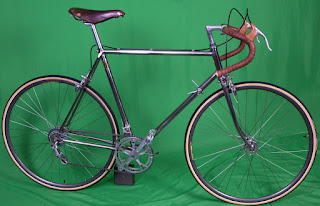If you're too old to be one of my grandchildren (as if I will ever have any!), you might remember a TV game show called Where In The World Is Carmen Sandiego? In it, the title character, who was the head of an international crime syndicate, would send one of her henchmen to steal a landmark. (That gives new meaning to "Wanna buy a bridge?") Contestants would use their knowledge of geography to track the thief from city to city and country to country. The contestant with the most points would have a chance to capture Carmen Sandiego.
Now, I am not involved with any crime syndicates--though I sometimes would say, "the Valinotti family" with, shall we say, just the right intonation. (OK, now you know the real reason I never lost a fight!) However, I will take over Ms. Sandiego's role and invite you to play "Where in the world is Justine Valinotti"?
Here's your first clue:
All right. There are lots of places where you can see fog and low clouds enshrouding buildings. So I'll give you another clue:
This house faces a park. Said park isn't Central, Prospect, Fairmount, Greenwich or the Luxembourg Gardens. However, it's in a city that has a park designed by the same person who desgined the first three I mentioned and was inspired by the other two.
Now I'll give you another clue:
So you know I'm in a French-speaking city. But it's not Paris, Toulouse or Dijon. Or Geneva.
OK, one more clue:
What French-speaking city might have a "Petite Italia"? Probably not Saigon. Or Port-au-Prince. Cayenne: I believe not. Almost certainly not Ouagadougou.
So if not in France, Africa the Caribbean, or Southeast Asia, where am I?
By now, you've probably guessed where I am:
Oui, je suis en Montreal! I arrived last night and checked into an interesting hotel run by an absolutely fabulous woman. More about her, and the hotel, later.
Since you're reading this blog, you're probably wondering whether I've used Bixi, this city's bike-share program. I haven't, mainly because I didn't ride at all. I was going to rent a bike today but decided against it because it was pouring when I woke up and the rest of the day was a series of drizzles, downpours and other variations of rain. So I went to an art exhibit and gallery, shopped and ate unhealthy but tasty foods.
One of those foods was indeed poutine. It's easy to see why it's one of the most emblematic foods of Quebec: Few things feel better on a cold, rainy day. Made with French fries and cheese curds smothered in brown gravy, it's also just the thing to eat when you want to thumb your nose at a sanctimonious, politically correct vegan you know.
I plan to rent a bike tomorrow and ride, sightsee and eat, not in any particular order.
I'll close this post with this, from the Place des Arts:
On the Sciences building of the Universite de Quebec a Montreal, images of Montreal's life, history and culture are projected onto the wall. In the surrounding neighborhood --the Quartier des Spectacles, not far from Montreal Vieux and the old port of Montreal--there are all sorts of shows and plays of light
Now, I am not involved with any crime syndicates--though I sometimes would say, "the Valinotti family" with, shall we say, just the right intonation. (OK, now you know the real reason I never lost a fight!) However, I will take over Ms. Sandiego's role and invite you to play "Where in the world is Justine Valinotti"?
Here's your first clue:
All right. There are lots of places where you can see fog and low clouds enshrouding buildings. So I'll give you another clue:
This house faces a park. Said park isn't Central, Prospect, Fairmount, Greenwich or the Luxembourg Gardens. However, it's in a city that has a park designed by the same person who desgined the first three I mentioned and was inspired by the other two.
Now I'll give you another clue:
So you know I'm in a French-speaking city. But it's not Paris, Toulouse or Dijon. Or Geneva.
OK, one more clue:
What French-speaking city might have a "Petite Italia"? Probably not Saigon. Or Port-au-Prince. Cayenne: I believe not. Almost certainly not Ouagadougou.
So if not in France, Africa the Caribbean, or Southeast Asia, where am I?
By now, you've probably guessed where I am:
 |
| Athena, holding an announcement for a series of lectures in Montreal. |
Oui, je suis en Montreal! I arrived last night and checked into an interesting hotel run by an absolutely fabulous woman. More about her, and the hotel, later.
Since you're reading this blog, you're probably wondering whether I've used Bixi, this city's bike-share program. I haven't, mainly because I didn't ride at all. I was going to rent a bike today but decided against it because it was pouring when I woke up and the rest of the day was a series of drizzles, downpours and other variations of rain. So I went to an art exhibit and gallery, shopped and ate unhealthy but tasty foods.
One of those foods was indeed poutine. It's easy to see why it's one of the most emblematic foods of Quebec: Few things feel better on a cold, rainy day. Made with French fries and cheese curds smothered in brown gravy, it's also just the thing to eat when you want to thumb your nose at a sanctimonious, politically correct vegan you know.
I plan to rent a bike tomorrow and ride, sightsee and eat, not in any particular order.
I'll close this post with this, from the Place des Arts:





